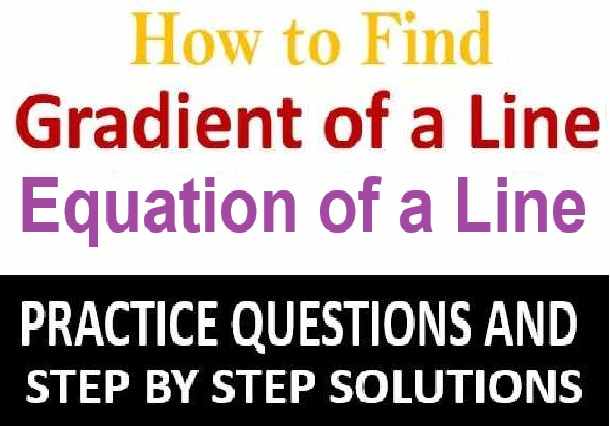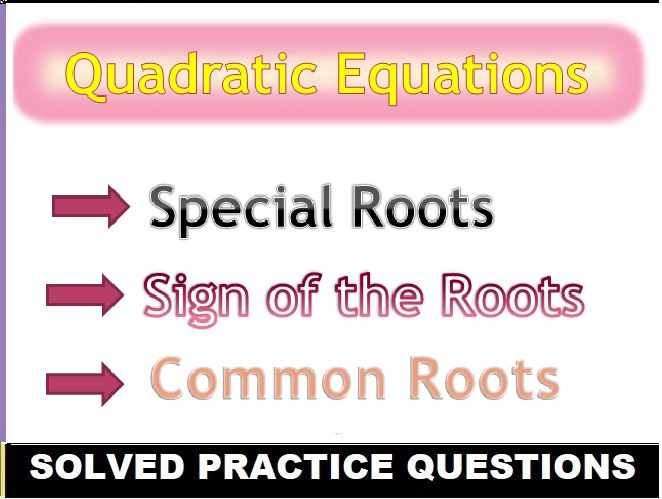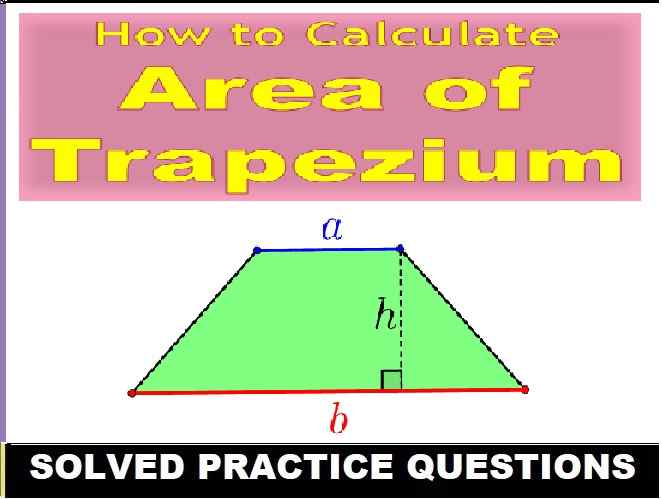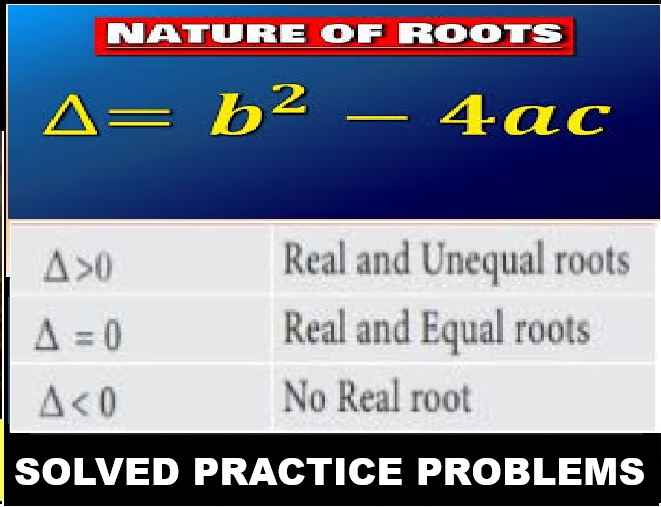Equation of a Straight Line Class 10 RS Aggarwal Exe-14A Goyal Brothers ICSE Maths Solutions Ch-14. We Provide Step by Step Solutions / Answer of Exe-14A Questions on Slope or Gradient and Slope Intercept Form. Visit official Website CISCE for detail information about ICSE Board Class-10 Mathematics.

Equation of a Straight Line Class 10 RS Aggarwal Exe-14A Goyal Brothers ICSE Maths Solutions Ch-14
| Board | ICSE |
| Subject | Maths |
| Class | 10th |
| Chapter-14 | Equation of a Straight Line |
| Writer Book | RS Aggarwal |
| Exe-14A | Slope or Gradient and Slope Intercept Form |
| Edition | 2024-2025 |
Slope or Gradient and Slope Intercept Form
The slope-intercept form of a straight line is y=mx + C , where: M is the slope of the line, also known as the gradient and C is y-intercept, or the point where the line crosses the y-axis
Note: The value of c can be positive or negative based on the intercept is made on the positive or negative side of the y-axis, respectively.
Slope, m = Change in y-coordinates/Change in x-coordinates m = (y2 – y1) / (x2 – x1)
m = (y2 – y1)/(x2 – x1)
Slope of a Line Equation
y − y1 = m(x − x1)
Exercise- 14A
( Equation of a Straight Line Class 10 RS Aggarwal Exe-14A Goyal Brothers ICSE Maths Solutions Ch-14 )
Que-1: Find the slope of the line passing through the points :
(i) A(-2,1) and B(3,-4)
(ii) A(0,-3) and B(2,1)
(iii) A(4,-9) and B(-2,-1)
(iv) A(2,5) and B(-4,-4)
Sol: (i) A(-2,1) and B(3,-4)
Slope = (y2-y1)/(x2-x1)
= (-4-1)/(3-(-2))
= -5/5 = -1.
(ii) A(0,-3) and B(2,1)
Slope = (y2-y1)/(x2-x1)
= (1-(-3))/(2-0)
= 4/2 = -2.
(iii) A(4,-9) and B(-2,-1)
Slope = (y2-y1)/(x2-x1)
= (-1-(-9))/(-2-4)
= 8/-6 = -4/3.
(iv) A(2,5) and B(-4,-4)
Slope = (y2-y1)/(x2-x1)
= (-4-5)/(-4-2))
= -9/-6 = 3/2.
Que-2: If the slope of the line joining P(k,3) and Q(8,-6) is -3/4, find the value of k.
Sol: P(k,3) and Q(8,-6)
Slope = (y2-y1)/(x2-x1)
-3/4 = (-6-3)/(8-k)
-24+3k = -36
3k = -36+24
k = -12/3 = -4.
Que-3: Without using distance formula, prove that the points A(1,4), B(3,-2) and C(-3,16) are collinear.
Sol: Slope from (1,4) to (3,-2) is (4-(-2)) / (1–3) = 6/(-2) = -3.
Slope from (3,-2) to (-3,16) is (-2–16) / (3-(-3)) = -18/6 = -3.
Since these are equal, the points are colinear (else they would be vertices of a triangle).
Que-4: Find the value of k such that the points P(k,1), Q(2,-5) and R(k-2,-3) are collinear.
Sol: Given, points P(k,1), Q(2,-5) and R(k-2,-3) are collinear.
∴ Slope of PQ = Slope of QR
(-5-1)/(2-k) = (-3-(-5))/(k-2-2)
-6/(2-k) = 2/(k-4)
-6k+24 = 4-2k
-6k+2k = 4-24
-4k = -20
k = 5.
Que-5: Find the equation of a line parallel to x-axis and passing through the point (-3,2).
Sol: Slope of line parallel means x = 0
Slope (m) = y-y1 = m (x-x1)
y-2 = 0 (x-(-3))
y-2 = 0
y = 2.
Que-6: Find the equation of the line parallel to y-axis and passing through the point (-7,5).
Sol: We know that a line is parallel to y-axis
Equation will be x = a
Passes through the point (-7,5)
Here, x = -7 and y = 5
a = -7 [x = a]
Hence equation of the line will be x+7 = 0.
Que-7: Find the equation of the line whose inclination is 30° and whose y-intercept is -2.
Sol: Angle of inclination = 30°
Slope of a line = tan 30°
(m) = 1/√3
y intercept (c) = – 2
Equation of a line is y = mx + c
y = (1/√3)x – 2
√3y = x – 2√3
∴ √3y-x+2√3 = 0.
Que-8: Find the equation of the line whose :
(i) Slope = 3/4 and y-intercept = -4
(ii) Gradient = √3 and y-intercept = -2/3
Sol: (i) Slope = 3/4 and y-intercept = -4
y = mx+c
y = (3/4)x + (-4)
4y = 3x-16
3x-4y-16 = 0.
(ii) Gradient = √3 and y-intercept = -2/3
y = mx + c
y = √3x + (-2/3)
3y = 3√3x – 2
3√3x – 3y – 2 = 0.
Que-9: Find the equation of the line which makes an angle of 60° with the positive direction of x-axis and passes through the point (0,-3).
Sol: Given: angle = 60°, Point (0,-3)
m = tan60° = √3
Equation of line
y-y1 = m (x-x1)
y-(-3) = √3 (x-0)
y+3 = √3x
√3x-y-3 = 0.
Que-10: Find the equation of a line :
(i) whose slope is 4 and which passes through the point (3,7)
(ii) whose slope is -3 and which passes through the point (-2,3).
Sol: (i) slope (m) = 4 and Point (3,7)
Equation of line
y-y1 = m (x-x1)
y-7 = 4 (x-3)
y-7 = 4x-12
4x-y-12+7 = 0
4x-y-5 = 0.
(ii) m = -3 and Point (-2,3)
Equation of line
y-y1 = m (x-x1)
y-3 = -3 (x-(-2))
y-3 = -3x-6
3x+y-3+6 = 0
3x+y+3 = 0.
Que-11: Find the gradient and y-intercept of each of the following lines :
(i) 5x-10y = 3 (ii) (x/6)+(y/9) = 1 (iii) x+4 = 0 (iv) y = 6
Sol: (i) 5x-10y = 3
-10y = 3-5x
y = (-3/10) – (5/10)x
y = (-3/10) – (1/2)x
m = 1/2 and c = -3/10.
(ii) (x/6)+(y/9) = 1
y/9 = (-x/6) + 1
y = (-x/6)9 + 9
y = (-3/2)x + 9
m = -3/2 and c = 9.
(iii) x+4 = 0
y = 0
m is not defined and the line has no y-intercept.
(iv) y = 6
y = 0x + 6
y = mx + c
On compare
m = 0 and c = 6.
Que-12: Find the gradient and the equation of the line passing through the points.
(i) A(-2,1) and B(3,-4)
(ii) A(4,-2) and B(2,-3)
Sol: (i) A(-2,1) and B(3,-4)
m = (y2-y1)/(x2-x1)
m = (-4-1)/(3-(-2))
m = -5/5 = -1
Equation of the line
y-y1 = m (x-x1)
y+4 = -1(x-3)
y+4 = -x+3
x+y-1 = 0.
(ii) A(4,-2) and B(2,-3)
m = (y2-y1)/(x2-x1)
m = (-3+2)/(2-4)
m = -1/-2 = 1/2.
Equation of the line
y-y1 = m (x-x1)
y+3 = (1/2) (x-2)
2y+6 = x-2
x-2y-8 = 0.
Que-13: A straight line passes through the points P(-1,4) and Q(5,-2). It intersects x-axis and y-axis at the points A and B respectively and M is the mid-point of AB. Find
(i) the equation of the line
(ii) the co-ordinates of A and B
(iii) the co-ordinates of M.
Sol: (i) Slope of PQ = (-2-4)/(5+1) = -6/6 = -1
Equation of the line PQ is given by
y – y1 = m(x – x1)
y − 4 = −1(x + 1)
y − 4 = −x − 1
x + y = 4 − 1
x + y = 3
(ii) For point A (on x-axis), y = 0.
Putting y = 0 in the equation of PQ, we get,
x = 3
Thus, the co-ordinates of point A are (3, 0).
For point B (on y-axis), x = 0.
Putting x = 0 in the equation of PQ, we get,
y = 3
Thus, the co-ordinates of point B are (0, 3).
(iv) M is the mid-point of AB.
So, the co-ordinates of point M are
[(3+0)/2, (0+3)/2]
= (3/2, 3/2).
Que-14: A(2,3) and B(-2,5) are two given points : Find
(i) the gradient of AB
(ii) the equation of AB
(iii) the co-ordinates of the point, where AB intersects x-axis
Sol: (i) Slope = (y2-y1)/(x2-x1)
= (5-3)/(-2-2)
= 2/-4 = -1/2
(ii) Equation of AB
y-3 = (-1/2) (x-2)
2y-6 = -x+2
x+2y-8 = 0.
(iii) AB intersect x-axis means y = 0
Substitute y = 0 in x+2y-8 we get
x+2(0)-8 = 0
x-8 = 0
x = 8
The point are (8,0).
Que-15: A straight line passes through the points A(2,-4) and B(5,-2) Find
(i) the slope of the line AB
(ii) the equation of the line AB
(iii) the value of k, if AB passes through the points P (k+3,k-4).
Sol: (i) Slope = (y2-y1)/(x2-x1)
= (-2-(-4))/(5-2)
= 2/3.
(ii) Equation of AB
y+2 = (2/3) (x-5)
3y+6 = 2x-10
2x-3y-16 = 0.
(iii) Point P (k+3, k-4) lies on this line
2(k+3) – 3(k-4) – 16 = 0
2k+6-3k+12-16 = 0
-k+2 = 0
k = 2.
Que-16: (i) If A(3,4), B(7,-2) and C(-2,-1) are the vertices of a ΔABC,write down the equation of the median through the vertex C.
(ii) A(2,5), B(-1,2) and C(5,8) are the vertices of a ΔABC, M is a point on AB such that AM : MB = 1:2. Find the coordinates of M. Hence, find the equation of the line passing through the points C and M.
Sol: (i) A(3,4), B(7,-2) and C(-2,-1) are the vertices of a ΔABC
CD is a median of AB
Co-ordinate of mid-point AB
[(3+7)/2, (4-2)/2]
[10/2, 2/2] = (5,1)
Slope of CD = (y2-y1)/(x2-x1)
= (-1-1)/(-2-5)
= 2/7
Equation of line CD
y-y1 = m (x-x1)
y+1 = (2/7) (x+2)
7y+7 = 2x+4
2x-7y-3 = 0.
(ii) Let the coordinates of M be (x, y).
Thus, we have
x = (m1x2+m2x1)/(m1+m2) = {1×(-1)+2×2}/(1+2) = (-1+4)/3 = 3/3 = 1
y = (m1y2+m2y2)/(m1+m2) = {1×(2)+2×5}/(1+2) = (2+10)/3 = 12/3 = 4
⇒ Co-ordinates of M are (1,4).
Slope of line passing through C and M = m = (4-8)/(1-5) = -4/-4 = 1
∴ Required equation is given by
y – 8 = 1(x – 5)
⇒ y – 8 = x – 5
⇒ y = x + 3.
Que-17: The vertices of a ΔABC are A(2,-11), B(2,13) and C(-12,1). Find the equation of its side.
Sol: The vertices of a ΔABC are A(2,-11), B(2,13) and C(-12,1)
equation of the line AB
(y-y1)/(x-x1) = (y-y2)/(x-x2)
(y+11)/(x-2) = (y-13)/(x-2)
(y+11)(x-2) = (y-13)(x-2)
xy-2y+11x-22 = xy-2y-13x+26
11x+13x = 26+22
24x = 48
x = 2.
Equation of BC will be
(y-13)/(x-2) = (y-1)/(x+12)
(y-13)(x+12) = (y-1)(x-2)
xy+12y-13x-156 = xy-2y-x+2
12y+2y = -x+13x+2+158
14y-12x-158 = 0 [divide by 2]
7y-6x = 79
Equation of CA will be
(y-1)/(x+12) = (y+11)/(x-2)
(y-1)(x-2) = (y+11)(x+12)
xy-2y-x+2 = xy+12y+11x+132
-2y-12y-x-11x = 132-2
-14y-12x = 130 [divided by -2]
7y+6x = -65.
Que-18: ABC is a triangle whose vertices are A(1,-1), B(0,4) and C(-6,4). D is the mid-point of BC. Find the (i) coordinates of D (ii) equation of the median AD.
Sol: (i) D is the mid-point of BC.
∴ Co-ordinates of D are [{(0-6)/2}, {(4+4)/2}]
i.e., (–3, 4).
(ii) Equation of median AD
y – y1 = {(y2-y1)/(x2-x1)} (x-x1)
⇒ y – (–1) = {(4-(-1))/(-3-1)} (x-1)
⇒ y + 1 = (5/-4) (x-1)
⇒ – 4y – 4 = 5x – 5
i.e. 5x + 4y = 1
Que-19: Find the equation of the line passing through the point (2,3) and intersecting the line 2x-3y = 6 on the y-axis.
Sol: 2x-3y = 6 passes through point of y-axis means x = 0
2(0)-3y = 6
-3y = 6
y = -2
line passes x-axis through point (0,-2)
A line is passing through the points A(2,3) and B(0,-2)
slope (m) = (y2-y1)/(x2-x1)
m = (-2-3)/(0-2)
m = -5/-2 = 5/2
We known the equation of line
y-y1 = m (x-x1)
y-3 = (5/2) (x-2)
2y-6 = 5x-10
5x-2y-4 = 0.
Que-20: Find the equation of a line with x-intercept = 5 and passing through the point (4,-3).
Sol: equation of a line with x-intercept = 5
point (4,-3)
Line passing through the point A(5,0) and B(4,-3)
Slope (m) = (y2-y1)/(x2-x1)
m = (-3-0)/(4-5)
m = -3/-1 = 3
Equation of the line
y-y1 = m (x-x1)
y-0 = 3 (x-5)
y = 3x-15
3x-y-15 = 0.
Que-21: Find the equation of the diagonals of a rectangle whose sides are: x = -1, x = 4, y = -1 and y = 2.
Sol: Equation of sides of triangles are x = -1, x = 4, y = -1 and y = 2
A(-1,-1), B(4,-1), C(4,2) and D(-1,2)
Slope of diagonal AC = (2-(-1))/(4-(-1))
= 3/5
Equation of AC will be
y-(-1) = (3/5) (x-(-1))
y+1 = (3/5) (x+1)
5y+5 = 3x+3
3x-5y-2 = 0.
Slope of BD is
(2-(-1))/(-1-4) = -3/5
Equation of BD will be
y-(-1) = (-3/5) (x-4)
5y+5 = -3x+12
3x+5y-7 = 0.
Que-22: Find the equation of the line passing through the point (3,2) and making positive equal intercepts on axes. Find the length of each intercept.
Sol: Let the line containing the point (3, 2) passes through x-axis at (x, 0) and y-axis at (0, y).
Given, the intercepts made on both the axes are equal.
∴ x = y
Slope = (0-y)/(x-0)
= -y/x
= -x/x = -1
Hence, the equation of the line will be
⇒ y – y1 = m(x – x1)
⇒ y – 2 = -1(x – 3)
⇒ y – 2 = -x + 3
⇒ y + x – 2 – 3 = 0
⇒ x + y – 5 = 0.
Que-23: Find the equation of the line passing through the origin and the point of intersection of the lines 5x+7y = 3 and 2x-3y = 7.
Sol: 5x + 7y = 3 ….(i)
2x – 3y = 7 ….(ii)
Multiply (i) by 3 and (ii) by 7,
15x + 21y = 9 ….(iii)
14x – 21y = 49 ….(iv)
Adding (iii) and (iv) we get,
⇒ 29x = 58
⇒ x = 2.
Substituting x = 2 in (i), we get
⇒ 5(2) + 7y = 3
⇒ 10 + 7y = 3
⇒ 7y = 3 – 10
⇒ 7y = -7
⇒ y = -1.
The equation of the line joining (2, -1) and (0, 0) will be given by two-point form i.e.,
y – y1 = {(y2-y1)/(x2-x1)} (x-x1)
Putting values in above equation we get,
y-(-1) = {(0-(-1))/(0-2)} (x-2)
y+1 = (-1/2) (x-2)
2y+2 = -x+2
x+2y = 0.
Que-24: M and N are two points on x-axis and y-axis respectively. P(3,2) divides the line segment MN in the ratio 2 : 3.
Find (i) the coordinates of M and N (ii) slope of the line MN.
Sol: Let coordinates of M is (a, 0) and M is (0, b).
Point P divides MN in 2 : 3 ratio
and ∴ 3 = (3a+2×0)/(3+2) and
2 = (3×0+2×b)/(3+2)
3a = 15 and 10 = 2b
a = 5 and b = 5
(i) The coordinates of M is (5, 0) and N(0, 5)
(ii) Slope of the line MN
(0-5)/(5-0) = -1
Que-25: In what ratio does the line x-5y+15 = 0 divide the join of A(2,1) and B(-3,6)? Also, find the coordinates of their point of intersection.
Sol: Let (x,y) divides the line segment AB k : 1
x = {(k×(-3)+1×2)/(k+1)} = (-3k+2)/(k+1)
y = {(k×6+1×1)/(k+1)} = (6k+1)/(k+1)
K lies on the line x-5y+15 = 0.
Point P = {(-3k+2)/(k+1)} – 5{(6k+1)/(k+1)} + 15 = 0
(-3k+2) – 5(6k+1) + 15(k+1) = 0
-3k+2-30k-5+15k+15 = 0
12 = 18k
k = 18/12 = 2/3
Coordinate of the point are
[{(-3k+2)/(k+1)}, {(6k+1)/(k+1)}]
[{(-3(2/3)+2)/((2/3)+1)}, {(6(2/3)+1)/((2/3+1))}]
[{(-2+2)/(5/3)}, {(4+1)/(5/3)}]
(0, 3).
Que-26: Find the equations of the medians of ΔABC whose vertices are A(-1,2), B(2,1) and C(0,4). Hence, find the co-ordinates of the centroid of ΔABC.
Sol: since AD,BE,CF are the medians of ΔABC
therefore D,E,F are the midpoints of BC, CA, AB respectively
Hence, coordinate of D = [{(2+0)/2}, {(1+4)/2}] = (1, 5/2)
Coordinate of E = [{(0-1)/2}, {(4+2)/2}] = (-1/2, 3)
Coordinate of F = [{(-1+2)/2}, {(2+1)/2}] = (1/2, 3/2)
Equation of median AD is given as
[{y-(5/2)}/{2-(5/2)}] = (x-1)/(-1-1)
x-4y+9 = 0.
Equation of median BE is given as,
(y-3)/(1-3) = [{x-(-1/2)}/{2-(-1/2)}]
4x+5y-13 = 0
Equation of median CF is given as
[{y-(3/2)}/{4-(3/2)}] = [{x-(1/2)}/{0-(1/2)}]
10x+2y-8 = 0.
Also the coordinate of the centroid O of ΔABC is given as
Ox = {Ax+Bx+Cx}/3 = {-1+2+0}/3 = 1/3
Oy = {Ay+By+Cy}/3 = {2+1+4}/3 = 7/3
{Ox, Oy} = {1/3, 7/3}.
Que-27: Three vertices of a parallelogram ABCD taken in order are A(3,6), B(5,10) and C(3,2). Find: (i) the coordinates of the fourth vertex D. (ii) length of diagonal BD. (iii) equation of side AB of the parallelogram ABCD.
Sol: Three vertices of a parallelogram taken in order are A(3, 6), B(5, 10) and C(3, 2)
(i) We need to find the coordinates of D.
We know that the diagonals of a parallelogram bisect each other.
Let x, y be the coordinates of D.
∴ Mid-point of diagonal AC = [{(3+3)/2}, {(6+2)/2}] = (3,4)
And midpoint of diagonal BD = [{(5+x)/2}, {(10+y)/2}]
Thus we have
(5+x)/2 = 3 and (10+y)/2 = 4
⇒ 5 +x = 6 and 10+y = 8
=> x = 1 and y = -2
∴D = (1,-2)
2) Length of diagonal BD = √[(1-5)²+(-2-10)²]
= √[(-4)²+(-12)²]
= √(16+144)
= √160
= 4√10
3) A(3,6) = (x1.y1) and B(5,10) = (x2,y2)
Slope of line AB = m{(y2-y1)/(x2-x1)} = (10-6)/(5-3) = 4/2 = 2
∴ Equation of line AB is given by
y-y1 = m (x-x1)
⇒ y-6 = 2(x-3)
⇒ y-6 = 2x-6
⇒ 2x-y = 0.
Que-28: In the given figure, ABC is a triangle and BC is parallel to y-axis. AB and AC intersect the y-axis at P and Q respectively.
(i) Write the coordinate of A (ii) Find the length of the AB and AC (iii) Find the ratio in which Q divides AC (iv) Find the equation of line AC
Sol: (i) The line intersects the x-axis where, y = 0. Thus, the coordinates of A are (4, 0).
2) Length of AB = √[(4-(-2))²+(0-3)²]
= √(36+9)
= √45 = 3√5 units
Length of BC = √[(4-(-2))²+(0-(-4))²]
= √(36+16)
= √52 = 2√13 units.
3) Let Q divides AC in the ratio m1 : m2. Thus, the co-ordinates of Q are (0, y)
Since x = (m1x2+m2x1)/(m1+m2)
⇒ 0 = {m1(-2)+m2(4)}/(m1+m2)
⇒ 2m1 = 4m2
⇒ m1 = 2m2
⇒ m1/m2 = 2/1
∴ Required ratio is 2 : 1
4) A(4, 0) = A(x1,y1) and B(-2,-4) = b(x2, y2)
Slope of AC = (-4-0)/(-2-4) = -4/-6 = 2/3
∴ Equation of line AC is given by y-y1 = m (x-x1)
⇒ y-0 = (2/3) (x-4)
⇒ 3y = 2x-8.
— : End of Equation of a Straight Line Class 10 RS Aggarwal Exe-14A Goyal Brothers :–
Return to:- ICSE Class 10 Maths RS Aggarwal Solutions
Please share with your friend
Thanks


